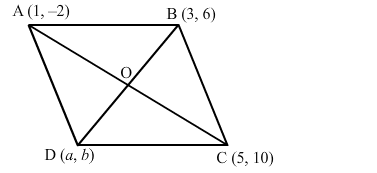If three consecutive vertices of a parallelogram ABCD are A(1, −2), B(3, 6) and C(5, 10), find its fourth vertex D.
If three consecutive vertices of a parallelogram ABCD are A(1, −2), B(3, 6) and C(5, 10), find its fourth vertex D.
Let A(1, −2), B(3, 6) and C(5, 10) be the three vertices of a parallelogram ABCD and the fourth vertex be D(a, b).
Join AC and BD intersecting at O.

We know that the diagonals of a parallelogram bisect each other.
Therefore, O is the midpoint of AC as well as BD.
Midpoint of $A C=\left(\frac{1+5}{2}, \frac{-2+10}{2}\right)=\left(\frac{6}{2}, \frac{8}{2}\right)=(3,4)$
Midpoint of $B D=\left(\frac{3+a}{2}, \frac{6+b}{2}\right)$
Therefore, $\frac{3+a}{2}=3$ and $\frac{6+b}{2}=4$
$\Rightarrow 3+a=6$ and $6+b=8$
$\Rightarrow a=6-3$ and $b=8-6$
$\Rightarrow a=3$ and $b=2$
Therefore, the fourth vertex is D(3, 2).
Click here to get exam-ready with eSaral
For making your preparation journey smoother of JEE, NEET and Class 8 to 10, grab our app now.
